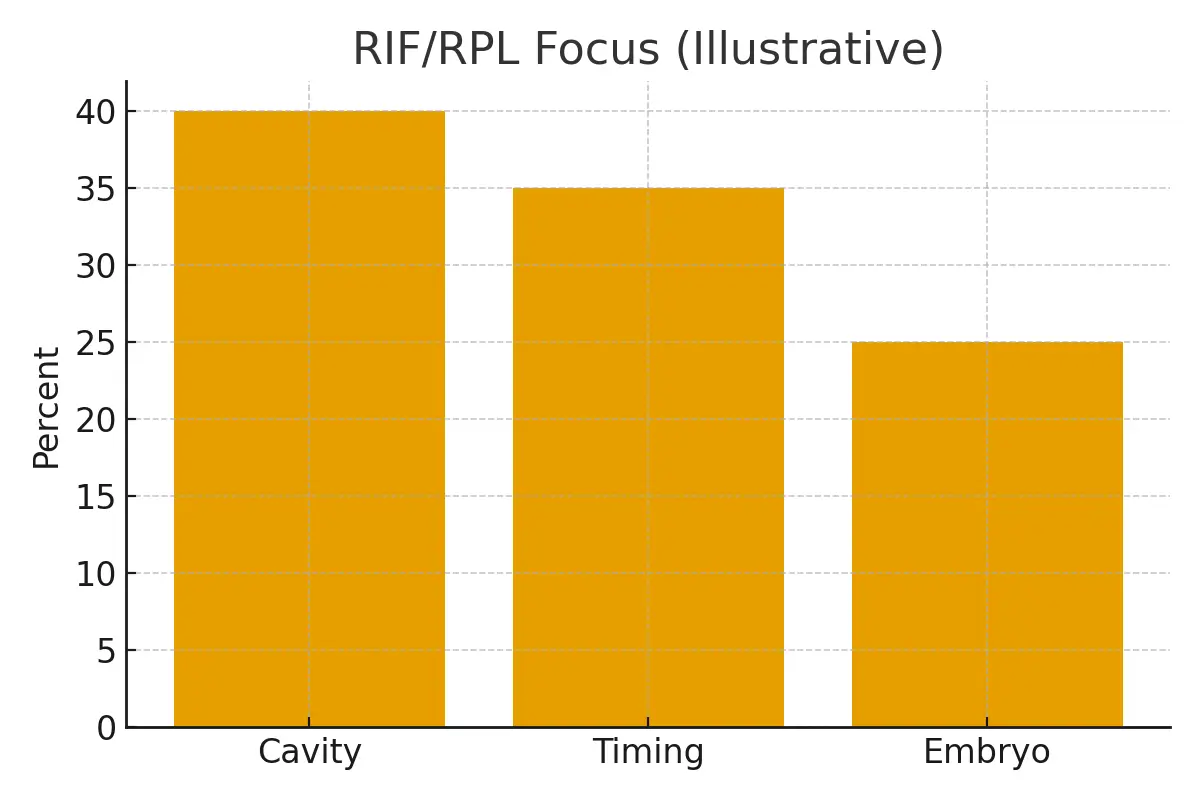
This article explains mock cycles within the Uterine & Implantation (RIF/RPL) pathway, focusing on decisions that actually impact outcomes, budgets, and timelines—helping you move forward with confidence.
What It Is
A mock cycle is a practice embryo transfer cycle that mimics medications and monitoring, without transferring an embryo. It allows clinicians to:
- Test uterine response and lining development.
- Confirm hormone timing and medication protocols.
- Reduce risks and improve planning for the actual embryo transfer.
Who It Helps
Mock cycles are most helpful for patients who:
- Have experienced recurrent implantation failure (RIF) or recurrent pregnancy loss (RPL).
- Show unpredictable endometrial response in previous cycles.
- Require personalized timing adjustments for frozen embryo transfers.
- Want to minimize risks and maximize the chance of success.
Step-by-Step
- Medication start: Same protocol as real transfer.
- Monitoring: Ultrasounds and blood tests track endometrial thickness and hormone response.
- Assessment: Confirm lining pattern, thickness, and readiness.
- Adjustments: Modify dosage, timing, or luteal support as needed.
- Finalize transfer plan: Use insights to optimize the real embryo transfer cycle.
Pros & Cons
Pros:
- Confirms correct medication and timing before embryo use.
- Reduces stress during the actual transfer.
- Detects potential issues with endometrial lining early.
Cons:
- Adds 1–2 weeks or more to overall timeline.
- Involves additional monitoring, appointments, and costs.
- Not always necessary for first-time IVF patients with predictable responses.
Costs & Logistics
- Line items: Medications, monitoring, lab tests, clinic visits.
- Insurance: Coverage varies; medications may or may not be included.
- Planning: Coordinate pharmacy, clinic calendar, and personal schedule to prevent delays.
What Improves Outcomes
- Using mock cycles only when indicated by history or prior cycles.
- Applying findings to fine-tune medication start, dose, and timing.
- Coordinating logistics (pharmacy, clinic, travel) to prevent missed windows.
- Documenting thresholds for lining thickness and hormone levels.
Case Study
A 38-year-old with two prior failed frozen transfers used a mock cycle. Monitoring showed her endometrial lining developed slower than expected. Adjusting medications and timing based on these results led to a successful transfer on her next cycle.
Mistakes to Avoid
- Performing mock cycles routinely without clinical indication.
- Ignoring the importance of exact protocol replication.
- Overlooking coordination with pharmacy or clinic schedules.
- Failing to implement findings from the mock cycle into the real transfer.
FAQs
Q. Do all IVF patients need a mock cycle?
Ans : No. Mock cycles are recommended mainly for patients with previous failed transfers, inconsistent lining response, or complex histories.
Q. How long does a mock cycle take?
Ans :Typically 3–4 weeks, similar in duration to a frozen embryo transfer cycle.
Q. Does a mock cycle use embryos?
Ans :No. It is purely diagnostic; no embryos are transferred during this cycle.
Q. What information does a mock cycle provide?
Ans :It evaluates how your uterus responds to medications, lining thickness, hormone levels, and timing for embryo transfer.
Q. Is insurance coverage available for mock cycles?
Ans : Coverage varies. Some insurers cover medications and monitoring, but patients should confirm specifics with both their clinic and insurer.
Next Steps
- Free 15-min nurse consult
- Upload labs for review
- Personalized cost breakdown for your cycle
Related Links

Dr. Kulsoom Baloch
Dr. Kulsoom Baloch is a dedicated donor coordinator at Egg Donors, leveraging her extensive background in medicine and public health. She holds an MBBS from Ziauddin University, Pakistan, and an MPH from Hofstra University, New York. With three years of clinical experience at prominent hospitals in Karachi, Pakistan, Dr. Baloch has honed her skills in patient care and medical research.





